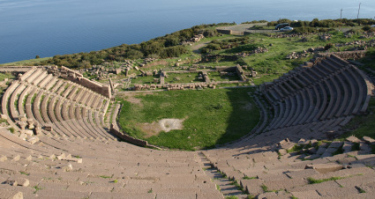Aristotle, after he left Athens, came to Assos and opened a school of philosophy in 348 B.C. This area experienced its greatest prosperity under the rule of Hermias.
The Persians attacked and gained controlled of the city a few years after Aristotle's school opened. They killed Hermias and caused Aristotle to flee to Macedonia, where he ending up tutoring a young Alexander the Great. When Alexander was just 22 years old he freed Assos from Persian rule. In 133 B.C. the Romans took control of the city.
Teaching in Troas
During his third missionary journey the apostle Paul and his traveling companions visited Troas for several days. Paul, wanting to stay in the city a few more hours to teach, sent his friends (which include Luke) ahead of him to Assos by boat. The sea journey was about 50 miles (80.5 kilometers).
Then we went on ahead to the ship and sailed to Assos, there intending to take in Paul; for he had so appointed, since he himself was going on foot. And after he met with us . . .
we came to Mitylene; And from there we sailed away, and on the following day we arrived opposite Chios; and the next day we arrived at Samos; and after staying at Trogyllium, the next day we came to Miletus; (Acts 20:13 - 15, HBFV).

After teaching for a few more precious hours Paul walked from Troas to Assos, a land trip of about 21 miles (33.8 kilometers). This walk afforded the apostle a chance to collect his thoughts and pray to God.
"But the time came when Apostle Paul too must depart. The vessel might arrive at Assos before him; and, whatever influence he might have with the seamen, he could not count on any long delay.
"He hastened, therefore, through the southern gate, past the hot springs, and through the oak-woods, - then in full foliage, - which cover all that shore with greenness and shade, and across the wild water-courses on the western side of Ida. Such is the scenery which now surrounds the traveler on his way from Troas . . .
"The great difference then was, that there was a good Roman road, which made Apostle Paul's solitary journey both more safe and more rapid than it could have been now. We have seldom had occasion to think of the Apostle in the hours of his solitude.
"But such hours must have been sought and cherished by one whose whole strength was drawn from communion with God, and especially at a time when, as on this present journey, he was deeply conscious of his weakness, and filled with foreboding fears" (The Life and Epistles of Apostle Paul by Conybeare and Howson, chapter 20).
He met up with his traveling companions in Assos where they then boarded a ship to Mitylene (Mytilene), which was (and still is) the chief city of the island of Lesbos. The residents of Lesbos were called Lesbians. The association of the word Lesbian to refer to female homosexuality is mostly derived from an early 7th century B.C. female poet named Sappho. A resident of the island, Sappho wrote passionately about her relationships with other women.